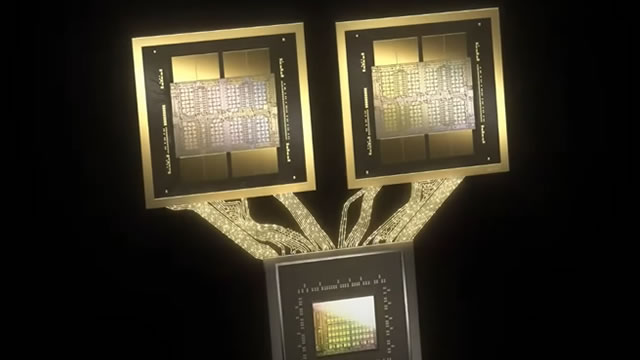Nvidia’s Efficiency Gains and Market Dynamics: A Changing Landscape for AI Inference
Nvidia Corporation, a leading technology company known for its graphics processing units (GPUs), has been making waves in the artificial intelligence (AI) industry with its efficiency improvements, particularly with the Blackwell GPUs. These advancements have been reducing overall demand for GPUs in AI inference, contradicting Jevons Paradox, which suggests that technological efficiency leads to increased consumption.
Jevons Paradox and Nvidia’s Efficiency Gains
The Jevons Paradox, named after the British economist William Stanley Jevons, states that technological progress often leads to an increase in the rate of resource consumption, rather than a decrease. However, Nvidia’s recent advancements in GPU efficiency are challenging this paradigm in the AI market.
With the Blackwell GPUs, Nvidia has managed to deliver significant improvements in power efficiency, resulting in reduced demand for GPUs per AI inference task. This is a double-edged sword, as it saves costs for consumers and organizations, but it also potentially hinders Nvidia’s growth prospects.
Competition from AMD and Market Dynamics
Competitors like Advanced Micro Devices (AMD) are capitalizing on these market dynamics, offering lower total cost of ownership for AI inference. AMD’s GPUs, while not as efficient as Nvidia’s, are more affordable, making them an attractive alternative for many consumers and organizations. This competition is putting pressure on Nvidia to maintain its market dominance and innovate to stay ahead.
Impact on Consumers and the World
For consumers, these efficiency improvements mean lower costs for AI applications, making them more accessible and affordable. This could lead to a wider adoption of AI technologies in various industries, from healthcare to finance, and could result in significant improvements in productivity and efficiency.
For the world, the impact of Nvidia’s efficiency gains and the resulting competition could lead to a more dynamic and competitive market for AI hardware. This could result in faster innovation, lower costs, and a wider adoption of AI technologies, ultimately benefiting society as a whole.
Investment Considerations
However, it’s important to note that Nvidia’s stock (NVDA) has a high valuation, which assumes near-perfect execution and sustained growth. Given the current market dynamics and potential for a significant correction, investors should approach NVDA with caution. The company’s future success will depend on its ability to innovate and differentiate itself from competitors, as well as the overall growth of the AI market.
Conclusion
Nvidia’s efficiency improvements in AI inference are challenging the traditional paradigm of Jevons Paradox and leading to a more competitive market. While this is good news for consumers and the world, it also presents challenges for Nvidia, as competitors like AMD offer lower total cost of ownership. As investors, it’s important to keep an eye on these market dynamics and consider the risks and opportunities in the AI hardware market.
- Nvidia’s efficiency improvements in AI inference are reducing overall demand, contradicting Jevons Paradox.
- Competitors like AMD are offering lower total cost of ownership for AI inference, challenging Nvidia’s market dominance.
- Consumers will benefit from lower costs for AI applications, leading to wider adoption and potential productivity improvements.
- Investors should approach NVDA with caution, given its high valuation and the competitive market dynamics.





